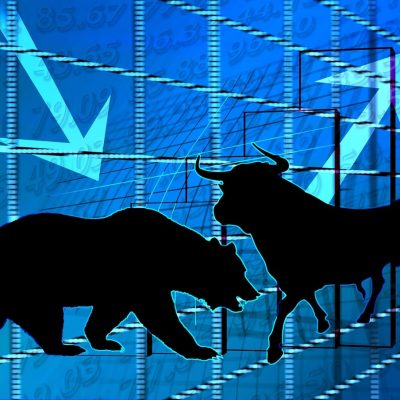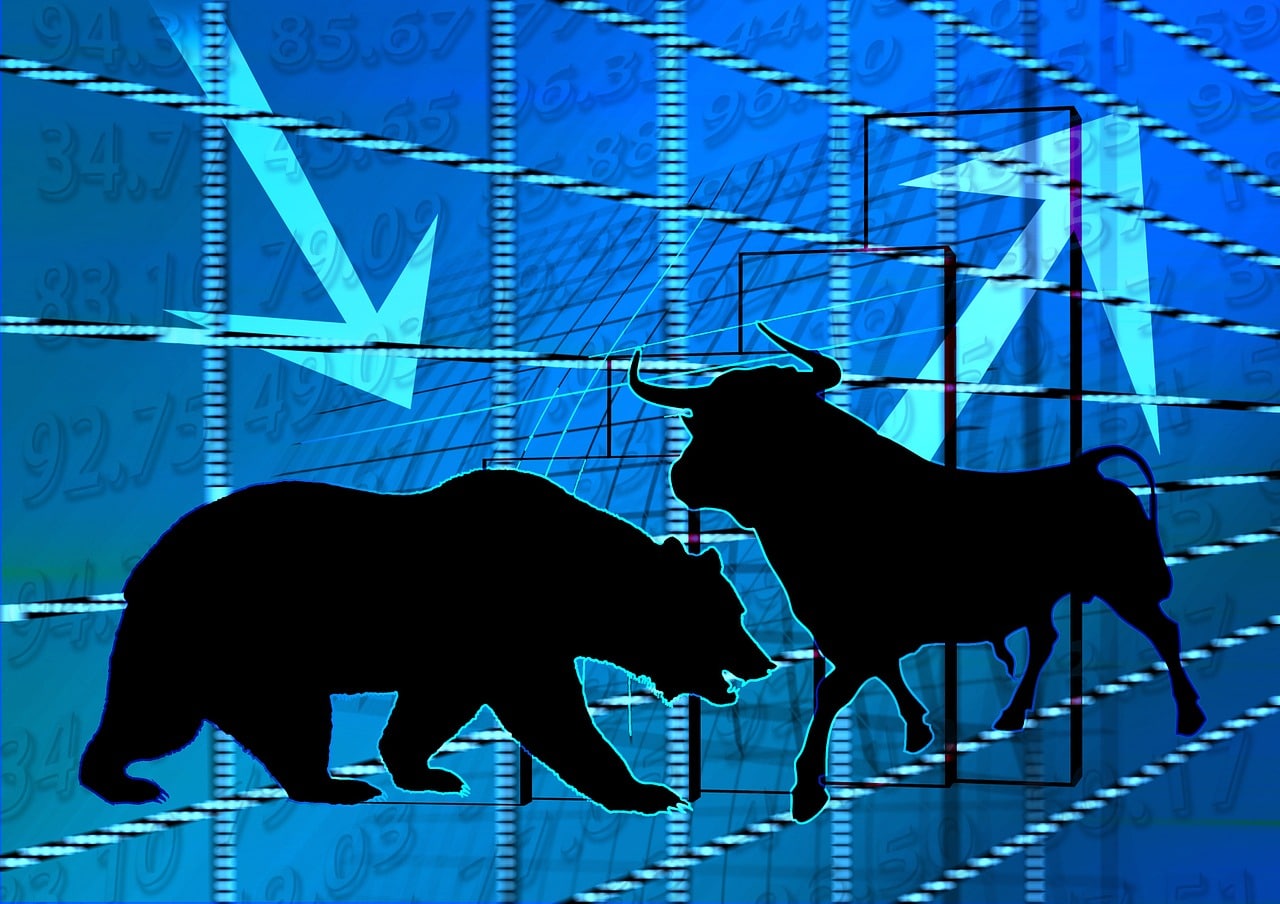Last updated on February 14th, 2022 , 10:09 am

There are a lot of new terms that beginner investors must learn. Some of them can be incredibly complicated; others are rather straightforward. This article is going to cover a few of the more straightforward trading terms.
Understanding the difference between bullish vs bearish as well as long vs short is vital. These terms are the building blocks upon which other investing narratives build. Let’s get right into it!
TAKEAWAYS
- “Bullish” investors believe prices will rise
- “Bearish” investors believe prices will fall
- A “Long” position indicates an investor owns a security
- A “Short” position indicates borrowed securities. Generally speaking, an investor “short” a security speculates the price will fall.
Bullish vs Bearish
What strange words the investing world uses to describe market direction! But at least they’re named after animals; at least they’re relatively fun.
Before we dive into the meanings of these two words, let’s do a brief history of their origin. Additionally, knowing how these terms came to be may help you remember them.
Origins of Bullish and Bearish

Ever watch a tourist get gored during the running of the bulls at the San Fermin Festival in Pamplona, Spain? If so, remembering what a “bull market” is will be easy for you.
When a bull attacks, the animal thrusts its horns into the air (along with any unsuspecting tourists from Ohio). In other words, the bull’s head goes “up”.
Since there are no “running of the bears” (yet), understanding what “bearish” means may not be as intuitive.
The origin of the term bearish is not as cut and dry. In truth, nobody can say for certain where it comes from. A deep dive revealed the history of the term bearish involved something called “bearskin jobbers”, trappers and medieval brokers. Let’s skip that definition and go on to the easier one, shall we?
A bear attacks by raising its giant paw and swatting prey down. Hopefully, you haven’t learned this empirically. This is how we will remember what a “bearish market” is: downward.
Bullish
The term “Bullish” is a metaphor for an upward trending market. If we are in a bullish market, prices keep going up, just like the body of that tourist. Bullish investors believe the price of a security or securities will rise in value.
Bearish
The term “bearish” is the exact opposite of bullish. A bullish market is a downward trending market. The stock market is considered bearish if the overall prices of stocks are falling.
When the pandemic hit, the market was bearish. When the economy rebounded, it was bullish. Therefore, bear markets are bad for an economy; bull markets are good.
Bullish and Bearish Sentiment

If you spend any time watching CNBC, you’ll hear the word bullish and bearish peppered into every other sentence. We learned before that a bullish market goes up and a bearish market goes down. But what about the future of a market?
If you believe a market is going to go up in the future, you are bullish. If you believe a market is going to go down in the future, you are bearish.
Nobody knows for certain which direction a market (any market at all) will go in the future, but those talking heads on TV sure do like to give their opinion on the matter. This bullish and bearish guessing is called “speculation”.
Market Neutral
Additionally, you can be neither bullish nor bearish. What is the word for this term? Not some sort of crossbred nightmare animal as I wish it were (Beull? Isn’t that a motorcycle?), but simply “neutral”. If you’re “market neutral” you don’t think a market is going to go anywhere at all.
Perhaps the best way to take advantage of a neutral market is with call-and-put options.
So now you can impress (or bore) your friends at the pub next Saturday with some new terms. But what if they fire back some other terms that you don’t understand? What if they say, “So you’re bullish; what exactly are you long?”
So what the heck does “long” mean? I’m 6’2, so I guess I’m long.
Long vs Short
Things get a little more complicated when we are talking about long and short. Let’s take a look at the (potential) origin of these terms so we can understand them better.
Origins of Long and Short
Trying to figure out the origins of long vs short becomes a bit more ambiguous. One theory is that the terms came from a medieval method of record-keeping called “tally sticks”, as seen below.

In old England, accountants of the crown made notches on these sticks to record proof of payment between parties. The stick was then split lengthways into two pieces; a long piece and a short piece. The long piece was then given to the “payer” and the short piece was given to the “seller”. At a later date, the parties would place the pieces together to make sure they fit in a process called “tallying”. This fitting together of the pieces confirmed that a previous transaction had indeed taken place.
I believe the UK Government has since updated its record-keeping methods.
Since the party who received that larger stick paid, they were considered “long’. The party that had the shorter piece of the stick “owed”, and was thus short. This may make the process of separating the two terms easier (or perhaps more difficult) for you.
Long
If you have a “long” position in an asset/security, you own that security. For the most part, if you are long something, you want it to go up in value. However, there are many exceptions to this rule (more on this in a bit).
You can use this term to describe anything you own. On a recent trip home, I remembered I was “long” several thousand baseball cards. Unfortunately, they have not gone up in value.
In the stock market, you can either be long or short stock. If you are long shares of Apple (AAPL), for example, you actually own part of that company. You can even vote on important decisions the company makes in something called a “proxy”. If you are long AAPL stock, you obviously want it to go up in value.
The vast majority of investors are long stocks. An investor who went long $100 worth of stocks within the S&P 500 in the year 1900 would have over $8.5 million today. That’s not a bad return. A lot of that return comes in the form of dividends. If you are long something, you have rights. Short sellers? Not so much.
Short
Selling short is the exact opposite of going long. An investor who shorts a stock speculates that that stock will decline in value.
How do you go about selling something you don’t own? The markets allow participants to borrow shares from a broker while simultaneously selling these shares. An investor who does this will profit when the stock goes down in value.
If the market does indeed decline in value, that investor can buy the shares back for a profit. When an investor buys back their short shares, they simultaneously return the borrowed shares to their broker, and they are “flat”, or have no positions.
Short Selling Example
If this concept sounds confusing (as it did to me when I first learned it) here’s a tangible analogy.
Let’s say your best friend just paid $500 for a new Xbox. Before he opens it, you ask to borrow it. He agrees. You then immediately sell it to someone else for $550.
There has been a lot of talk about banning short selling. This would be a mistake (and very unlikely). The ability to sell short is a cornerstone of capitalism. If short sellers didn’t exist, the stock market would rise inexorably before crashing epically.
Just think about what would happen during a debate if you were only allowed to agree.
GameStop and Short-Selling

Short selling has significant risks. You may recall the GameStop (GME) battle of 2021 between Reddit and Wall Street. If you buy a stock at $20 and sell it for $300, you just made $280 a share. Not bad!
However, if you sell shares of GME (as many hedge funds were doing) at $20, and GME rises to $300, you just lost $280/share. The losses precipitate, and what follows is a herd of short-sellers rushing to cover their positions in what is called a “short squeeze”.
When selling short stocks, you can lose a lot more than you invest. When you go long a stock, you can only ever lose 100% percent of your initial investment (assuming the stock goes to zero).
Something called “gamma squeeze” happened on this stock as well. Learn more about this options trading term here, “Gamma Squeeze Explained“.
Short Selling = Infinite Risk
When you short a stock, you have in theory infinite risk, since there is no telling how high that stock may go. This can lead to what is called a “margin call”. This happens when your broker says, “Alright, you lost a lot of money on this short stock; what if the stock continues to go up and you don’t have the funds to cover the losses? Then we’re at risk. We require more money for you to hold the position, or we’re going to liquidate your account.”
In short (no pun intended), just know that if you short a stock, you want it to go down in value. The mechanics can get quite complicated.
So by now you probably think that “long” is synonymous with “bullish and “short” is synonymous with “bearish”: Why aren’t they just the same word?
Sometimes, a long position can actually be bearish, and a short position bullish. Let’s take a look at a few of these exceptions.
Exceptions to the Rule
Chances are that if you’ve heard of GameStop, you’ve heard of options trading as well. Options trading allows investors great leverage in the marketplace. Instead of trading stock, an options trader is buying the right to either buy or sell stock.
There are two types of options contracts; calls and puts:
- A “put option contract” is a financial derivative that allows an investor to profit when a stock goes down in value. Put contracts give an investor the right to sell shares of stock at a specific price (strike price) by a certain date (expiration date). Unlike stock, options are contracts, and thus expire over time.
- A “call option contract” is a financial derivative that allows an investor to profit when a stock goes up in value. Unlike put contracts, call contracts give an investor the right to purchase shares of stock at a specific price (strike price) by a certain date (expiration date).
If you are “long” a “put contract”, you are betting that the market will go down in value. Therefore, not all long positions are bullish.
Huge profits are made and lost in options trading. If you’d like an introduction to options trading, feel free to check out our free YouTube guide below. Over 10 million YouTubers have already done so!
Option Trading for Beginners
Final Word
The majority of the time, you can equate long with being bullish, just as you can equate short with being bearish. If you’re only talking about individual stocks, you will generally be safe. Some exchange-traded funds (ETFs), however, actually are designed to make money when the market goes down.
For long-term investors, bullish and long is generally the only way to go.
Thanks for reading, and happy trading!
